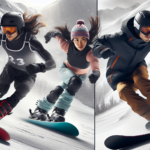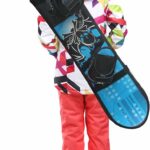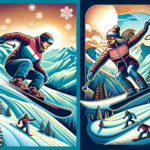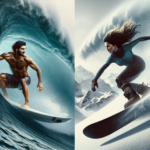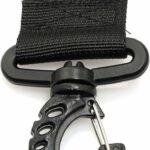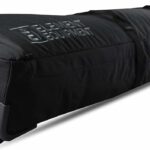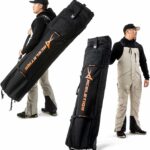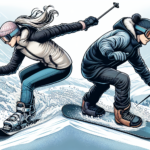You are standing at the top of a snow-covered hill, feeling the cold air against your skin, it’s decision time. Will you strap both feet into a board and slide down sideways, or harness yourself into two skis? It’s the age-old winter debate: skiing or snowboarding, which is cooler? As you explore this riveting discourse, you’ll dissect the thrill quotient, fitness benefits, and culture surrounding both winter sports, tilting the scales to answer the ultimate question — which one rules the slopes?
Exploring the Popularity
Winter sports are a popular pastime around the world, providing adrenaline and skills development to enthusiasts. Among these, skiing and snowboarding stand out as firm favorites.
Cultural Perception of Skiing
In cultural perception, skiing over the years has been seen as a more traditional winter sport. Sometimes it’s seen as a socioeconomic status symbol, with the involvement of high-end resorts and posh ambiance. Skiing holds a prestigious reputation and has widely been accepted as a family-friendly activity that spans across generations.
Cultural Perception of Snowboarding
On the other hand, snowboarding is widely perceived as a more recent development to winter sports, often associated with a younger, more “hip” crowd. This thrilling sport has roots in skateboarding and surfing cultures, attributing to its edgy, modern, and freestyle status.
Age Popularity of Skiing and Snowboarding
Skiing is often introduced at a younger age, with many taking ski lessons as children. Its popularity spans a wider age range, from young children to senior citizens. Snowboarding also has a young demographic but seems to particularly resonate with teenagers and young adults, given its reputation as a more freestyle and edgy sport.
Geographical Preference for Skiing and Snowboarding
Geographically, both sports are the most popular in regions graced with snowy seasons, especially mountainous areas. While you’ll find both skiers and snowboarders on most slopes, certain countries and regions have preferences. Alpine countries such as Austria and Switzerland are traditionally more inclined towards skiing, whereas snowboarding is especially popular in countries like the United States and Canada.
Technique and Mastery
Degree of Difficulty in Skiing
Skiing is often seen as easier to learn initially due to the lateral stability provided by two separate skis. The ability to move both legs independently can help beginners navigate the slopes and maintain balance. However, mastering more advanced skiing techniques can take many seasons of practice.
Degree of Difficulty in Snowboarding
Snowboarding stands out for its steep learning curve. Initially, it may feel harder compared to skiing because it requires better balance and coordination skills linked to keeping both feet locked in one board. But once you’ve got the basics down, skill advancement can be more linear than skiing.
Skill Progression in Skiing and Snowboarding
Both skiing and snowboarding require considerably different sets of skills. In skiing, the progression may involve transitioning from “snowplows” to parallel turns, and eventually to carves and moguls. For snowboarding, you’ll move from falling leaf techniques to linking turns, and then to more advanced moves like jumps and tricks for freestyle riding.
Posture and Body Mechanics in Skiing vs Snowboarding
For mechanics and posture, skiing requires a forward-facing position with your body perpendicular to the mountain. This might feel more natural and intuitive for beginners. Snowboarding, on the other hand, requires a sideways stance, which can initially feel more awkward but becomes comfortable with time and practice.
Safety Comparisons
While both skiing and snowboarding provide a thrilling escape, they do come with their risks.
Injury Risks in Skiing
Skiing accidents often involve awkward falls resulting in knee injuries. There’s also the risk of “skier’s thumb,” a specific injury caused by falling while holding ski poles.
Injury Risks in Snowboarding
Snowboarding injuries more frequently involve the wrists, arms, and upper body as you’re more likely to fall sideways or forward due to the single board.
Required Safety Equipment in Skiing
Safety equipment for skiing includes helmets, ski bindings to prevent joint injuries, body armor, and wrist guards.
Required Safety Equipment in Snowboarding
Snowboarding requires similar safety gear to skiing but with more emphasis on wrist guards due to the greater risk of wrist injuries. A helmet, protective shorts, and knee pads are also essential.
Athletic Requirements
Both skiing and snowboarding are physically demanding sports.
Physical Fitness Required for Skiing
Skiing requires strength in the lower body and core, along with good balance and flexibility. Cardiovascular fitness is also vital to handle lengthy descents.
Physical Fitness Required for Snowboarding
Snowboarding places significant demands on the core and legs, especially quads. Flexibility and balance are also key, along with a good level of cardiovascular fitness.
Cross-Training Options for Skiers
Off-season training for skiers could include cycling, swimming, and strength training activities to build endurance, strength, and flexibility.
Cross-Training Options for Snowboarders
For snowboarders, activities like skateboarding, surfing, and yoga are great off-mountain cross-training options, developing balance, agility, and flexibility.
Equipment and Gear
Both sports require specific equipment to navigate the slopes safely.
Types of Skiing Gear
Essential skiing gear includes skis, ski boots, poles, helmet, ski pants, ski jacket, goggles, and gloves. Equipment differs for Alpine, nordic and backcountry skiing.
Types of Snowboarding Gear
Categorized as snowboarding gear are snowboards, snowboard boots, bindings, helmet, snowboard pants, snowboard jacket, goggles, and gloves. The choice of equipment will depend on the style of snowboarding favored, such as freestyle, freeride or alpine.
Cost Differences between Skiing and Snowboarding Equipment
While costs can vary based on brand and quality, generally, the cost of basic equipment for both sports is comparable. A complete beginner set-up for either can range anywhere from a few hundred to a thousand dollars.
Equipment Maintenance for Skiing vs Snowboarding
Maintenance keeps your gear in top shape. For skis, this means regular waxing, edge sharpening, and possible base repairs. For snowboards, waxing and edge care are also required, with additional attention to the bindings.
The Social Aspect
Different communities surround each of these sports.
Skiing Social Culture
Skiing has a broad appeal and is seen as a sport that promotes camaraderie. The après-ski, the social activities following a day of skiing, is a cherished tradition in the skiing world.
Snowboarding Social Culture
Snowboarding culture leans more towards a relaxed, freestyle attitude echoing its roots in skateboarding and surfing. It also promotes a sense of camaraderie, but with a more laid-back, adventurous vibe.
Inclusion and Diversity in Skiing vs Snowboarding
Both skiing and snowboarding communities have been making strides towards inclusion and diversity recently. There’s been a noticeable push to invite more women, members of the BIPOC community, and individuals with disabilities into the world of winter sports.
Community and Competitions in Skiing and Snowboarding
Competitions in both skiing and snowboarding span from local league events to international championships, promoting community involvement, friendly competition, and pushing skills advancement. Famous events include the Winter X Games, the Freeride World Tour, and most notably, the Winter Olympics.
Aesthetics and Style
Visual differences set skiing and snowboarding apart.
Visual Appeal of Skiing
The grace and fluidity of skiing offers a visually appealing spectacle, especially when carving down steep slopes or navigating through moguls.
Visual Appeal of Snowboarding
Snowboarding’s appeal lies in its dynamic movements. Its visual spectacle unleashes when watching a snowboarder perform tricks or navigate off-piste terrain.
Trends in Skiing Outfits
Skiing outfits tend to be more fitted, aiding in aerodynamics. The trends have been leaning towards bright colors and matching sets in recent years.
Trends in Snowboarding Outfits
Snowboarding outfits chirp a baggier tune for comfort and to accommodate dynamic movements. The pallet swings from bright, flashy designs to more subtle and sleek styles.
Impact on Nature
Outdoor sports like skiing and snowboarding have an impact on the environment.
Environmental Impact of Skiing
Skiing can impact the environment in various ways, including habitat fragmentation due to piste grooming, and water and energy use for snowmaking.
Environmental Impact of Snowboarding
The environmental impact of snowboarding mirrors that of skiing, as both activities take place in similar settings.
Sustainability Practices in Skiing and Snowboarding
Given the nature-dependent charm of both sports, sustainability practices are gaining momentum. This includes efforts like emphasizing recycling, renewable energy usage on the slopes, promoting off-piste skiing and snowboarding to minimize ecosystem disturbance, and sustainable gear production.
Learning Curve
Getting started in either skiing or snowboarding presents unique challenges.
Ease of Learning Skiing
Many find skiing easier to pick up at first. This is primarily due to the body’s natural alignment to the slope and the independent movement of each ski.
Ease of Learning Snowboarding
Snowboarding may present a steeper learning curve with more initial falls as beginners learn to balance on a single board. But fear not, once the basics are down, progression can be swift.
Availability of Skiing Lessons
Skiing lessons are widely available at most resorts and often extend from beginner to advanced levels. Furthermore, there are loads of online resources available for remote learning.
Availability of Snowboarding Lessons
Similarly, snowboard lessons are widely available too. Most ski resorts offer snowboarding lessons ranging from beginner to advanced levels. Plus, online tutorials and guides are abundant for off-slope learning.
Personal Preferences
When looking at skiing versus snowboarding, it mostly boils down to personal preferences.
Factors Influencing Individual Preferences
Numerous factors play into whether you might prefer skiing or snowboarding. These can include your physical fitness, coordination and balance abilities, patience in learning, love for speed or tricks, age, and even which sports you find cooler.
Testimonials from Skiers
Skiers often praise the sport for its speed, array of technique variations from downhill to cross-country, and the more natural, intuitive feel of the body position.
Testimonials from Snowboarders
Snowboarders love the sport for its freedom, the challenge that comes with the initial learning process, and the thrill of mastering tricks and jumps.
Combining Skiing and Snowboarding
Some winter sports enthusiasts decide not to settle for one or the other – they blend skiing and snowboarding. So why not try both? You’ll double your fun, develop a diverse set of skills, and get the best of both worlds from these fantastic winter sports.
In conclusion, whether skiing or snowboarding is cooler is purely subjective. It all boils down to you – your style, your vibe, and your preferences. So, hit the slopes and let the mountains guide your ride.
- What Snowboard Bindings Should I Get? - January 23, 2024
- What Size Screws For Snowboard Bindings? - January 23, 2024
- How To Snowmobile On Water? - January 23, 2024

